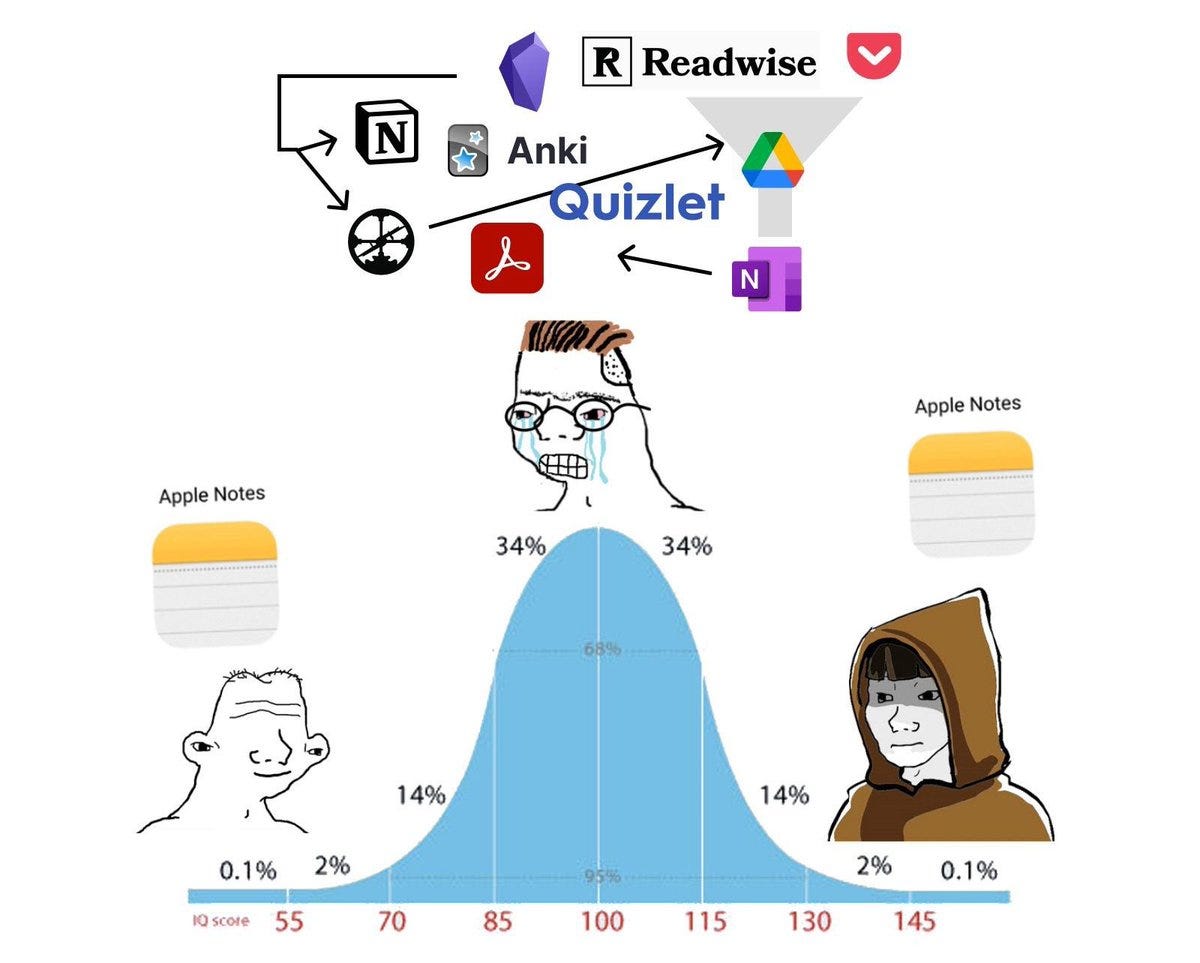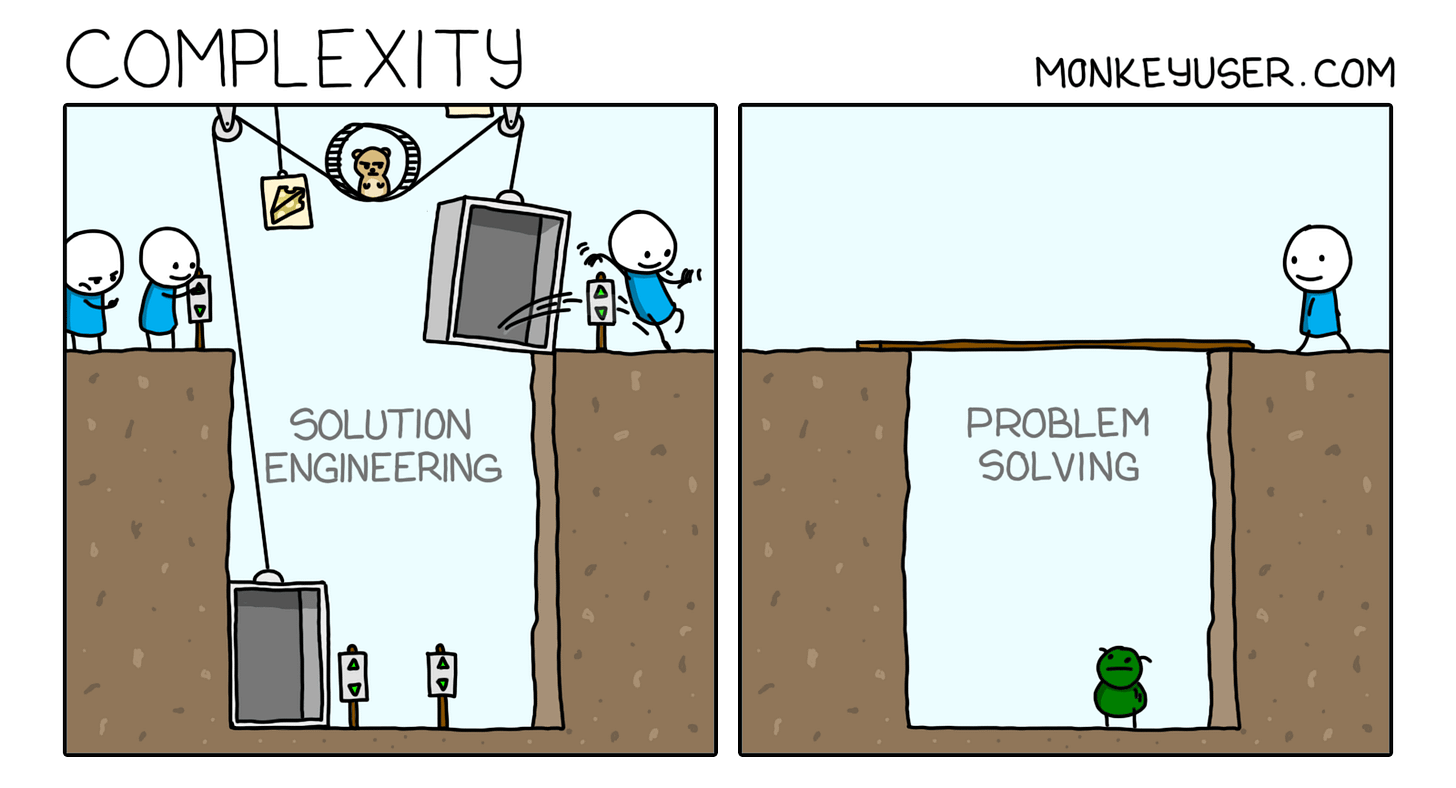If my work looks simple, I'm replaceable
Why Teams Choose Complexity Over Results
Complexity looks like progress, but it’s actually self-preservation.
I can spot it in the first 10 minutes of the dreaded Monday morning standup. Someone’s waffling about why something simple took three days. Honestly, they’re not stupid. They’re scared.
Most roles don’t have clear metrics, if any metrics at all. So people deconstruct existing processes, rebuild them in more complex ways, and present that complexity as proof of value. What’s worse is managers buy it.
If my work looks simple, I’m replaceable. If it looks complicated, I’m essential.
So people add unnecessary steps. They create dependencies. They become the one-eyed visionary in the land of the blind, the only person who understands the complex system they just built. This is job security through controlled complexity.
I’ve watched it destroy momentum and the will to live over and over.
It’s not malice. It’s fear. Nobody wants to be the person whose job looks easy because easy jobs get cut first. So they make it look hard.
The marketing manager could update the site in 10 minutes but writes a three-page brief. The PM schedules a workshop instead of making a call. The analyst builds a model to prove what they already know. All symptoms of the same disease.
The hidden Incentive
The problem isn’t people. It’s what the system rewards.
Performance reviews celebrate completed projects, not killed ones. More dashboards. More process. More noise. Complexity becomes career insurance.
So people build layers. More process. More dashboards. More meetings. Not to make things better, but to make themselves harder to remove. They are products of the system.
Clarity is dangerous. It pinpoints who’s actually moving the needle and who’s just orbiting around it. Complexity keeps everyone safe.
In most companies, complexity equals job security and that’s rational behavior in a broken system.
Once you see it, you can’t unsee it.
How to spot it in your own company
Marketing gives a tour of the stack. Slides, logos, arrows everywhere. It looks like a nuclear control room. Then you ask which tool created revenue last month?
Silence.
There’s probably no right answer, but the silence highlights the thought didn’t even cross their mind. It was never the objective.
The stack keeps growing. The results don’t. But at least, the integrations map looks impressive in the deck.
Then there’s the dashboard nobody opens. You know the one. The attribution model nobody understands. Months of work that change nothing.
I’ve watched a fintech startup spend four months building dashboards with 200+ metrics. Interactive filters. Color codes. Drill-downs. The execs stood up and clapped.
Nobody opened it again.
They needed 3 numbers, revenue, churn, CAC. Four months of work. Zero decisions made. The analytics team still got promoted. In most companies, effort is the product. The actual product is just proof you were busy.
Ask someone to explain their impact in one sentence. If they need a slide deck, they don’t have impact. They have activity. Activity looks like a job. Impact looks like you did less than you did. So people choose activity.
Same story in product.
We tested 40+ button shades. We never fixed onboarding. This is perfect optimisation of the wrong problem.
Everyone’s working hard but nobody’s making progress.
Simplicity doesn’t look sophisticated. And nobody gets fired for looking busy, they get fired for looking idle. So you get dashboards. Reports. Meetings. A full calendar that hides an empty impact.
Does any of it change what we do tomorrow? Of course not.
I’ve seen companies with 3 revenue streams and 15 ways to measure them. The measurement becomes the work.
Complexity is how companies hide failure. The more broken the system, the fancier the charts. Every mess hides behind a prettier dashboard.
The saddest part is most of the people doing this mean well. They think showing how simple it could be makes them disposable.
But in startups, the people who make things simpler are the ones everyone remembers.
Why complexity wins, even when it loses
Complexity is visible.
You can show the org chart. The process map. The dashboard. Look at all this work.
Simplicity is invisible. “We track 3 metrics now instead of 50.” Sounds like you did less work. Even if those 3 metrics actually drive decisions and the 50 didn’t.
Busy is far safer.
Knowing what matters requires being right.
So how do you spot the people who’ve figured this out?
Mastery is knowing what to ignore
The data team that shows 3 numbers instead of 50. The marketer who kills 10 campaigns to focus on one channel. The analyst who matches emails instead of building multi-touch attribution.
Mastery is making it look easy. Which means people undervalue it.
That’s the tax on being good at your job, you make it look like there was no job to do.
But here’s what separates good companies from the rest, is they recognise this tax and refuse to charge it. They promote the person who deleted useless metrics, not the one who added them. They reward the designer who removed three steps from onboarding, not the one who redesigned the same page four times.
Your north star
If your work is easy to explain, people assume it’s easy to do. If your work is complex to explain, people assume it’s valuable.
This is totally backwards. But it’s also reality and it’s why teams default to complexity.
The hardest part about simplicity is it leaves you nowhere to hide. No dashboards to point to. No process maps to walk through. No busy work to mistake for progress.
Just results. Or the lack of them. Most people can’t handle that level of clarity.
Which is exactly why the people who can are the ones you want to keep.
The people who make things simpler are rare.
Don’t punish them for it.
Martin, Chief Ranter at Uncharted
P.S. If this hit a nerve, subscribe to Uncharted if you want more of this. I write about startup growth without the fairytales.
This week’s track is Experience by Ludovico Einaudi.





People think if it is simpler, it is dumber.
Somehow that's how it look; dumber, but not how it is.
Spot on. Too many startups act like mini-corporates instead of treating themselves as projects searching for a business model — not companies preserving one.